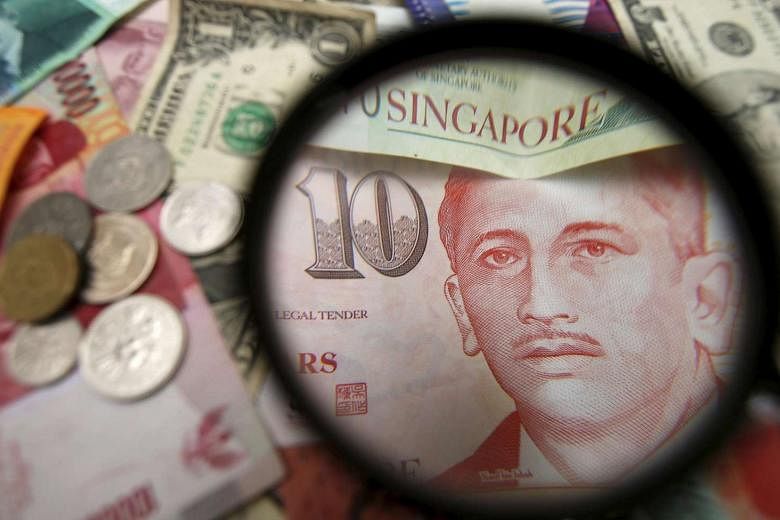SINGAPORE (BLOOMBERG) - Haven buying of the Singapore dollar amid global market turmoil has pushed a gauge of its strength to unprecedented levels, putting pressure on the city's central bank to do more to support the economy.
The Monetary Authority of Singapore's trade-weighted measure of the currency reached a record high after Britain voted to exit the European Union. It has reversed losses incurred after the MAS surprised markets by moving to a neutral policy of zero percent appreciation in April. That's prompting ABN Amro Bank, Royal Bank of Scotland and Nomura Holdings to predict more easing. The next review is due in October.
While Singapore's top credit rating and current-account surplus is luring money, along with nations such as Japan and South Korea, the city's economy is sputtering. Gross domestic product barely grew in the first quarter from the previous three months and the government predicts non-oil exports will shrink this year. Consumer prices have been declining since November 2014 and retail sales, excluding cars, fell in the three months though April.
"The risk of MAS easing in October has increased," said Roy Teo, a senior currency strategist at ABN Amro in Singapore. "Global GDP will be lower, and this will have repercussions on Singapore's growth. The Singapore dollar strength against currencies of Singapore's main trading partners poses a strong downside risk to export and inflation forecasts."
As of 4:50 pm in Singapore on Thursday (July 7) the local currency had advanced against 10 of its 16 major peers since the June 23 UK referendum, with the biggest gain of about 14 per cent against the British pound and 4 per cent against the Swedish krona. It lost 5.5 per cent against the Japanese yen and 1.1 per cent versus the Brazilian real.
April's move was the MAS's second unexpected decision in less than 16 months, following an emergency policy change in January last year to combat the threat of deflation. The last time the central bank shifted its currency policy to zero appreciation was in October 2008, when Singapore's economy was in a recession.
The authority guides the local dollar against an undisclosed basket of Singapore's trade partners and competitors. It intervenes in the market to keep the exchange rate within an unspecified band and changes the slope, width and center of that band when it wants to adjust the pace of appreciation or depreciation of the currency. Nomura, ABN Amro and RBS expect the MAS to lower the midpoint of the band.
Nomura cut its 2016 growth estimate for Asia to 5.6 per cent from 5.9 per cent on June 24, saying Brexit's global impact shouldn't be underestimated given the UK's position as a financial hub, and the risk of more countries leaving the EU. Singapore and Hong Kong's economies will be among the hardest hit given their very open nature, according to Rob Subbaraman, chief economist for Asia ex-Japan at the brokerage.
Singapore's government in May maintained its 2016 GDP growth forecast of 1 per cent to 3 per cent. That's less than the 3.5 per cent average expansion in the preceding five years. It projected a decline in non-oil domestic exports of 3 per cent to 5 per cent this year, compared with a February projection of a zero to 2 per cent increase. The MAS in June predicted inflation will average between minus 1 per cent and 0 per cent, compared with minus 0.5 per cent in 2015.
The local dollar has appreciated 5.3 per cent against the greenback this year, the third-best performance in Asia. The currency will weaken to 1.40 by end-2016, according to the median estimate of analysts in a Bloomberg survey.
Standard Chartered expects the MAS to maintain its current monetary policy setting in October, with its Singapore- based currency strategist Divya Devesh saying 2016 growth would need to drop below 1 per cent to trigger further easing. Australia & New Zealand Banking Group estimates the Singapore dollar is trading on the strong side of the midpoint of the MAS's policy band, which could complicate any potential easing.
"To re-centre when the Singapore dollar's NEER is this high would require MAS to immediately intervene to weaken the currency," said Khoon Goh, ANZ's head of Asia research in Singapore. "While the economic outlook is uncertain, it's not clear whether there will be large downside adjustments to Singapore's growth and inflation."
Singapore's GDP probably expanded an annualized 2 per cent in the second quarter from the same period a yer ago, according to the median estimate of economists surveyed before preliminary figures due July 14. That would be faster than 1.8 per cent in the first quarter.
"There's a reasonable possibility the MAS moves in October," said Vaninder Singh, a Singapore-based economist at RBS. "We will get an indication before the event. You'll see the MAS push the NEER to the lower side of the band, and that will be a clear indication that something might be coming."

